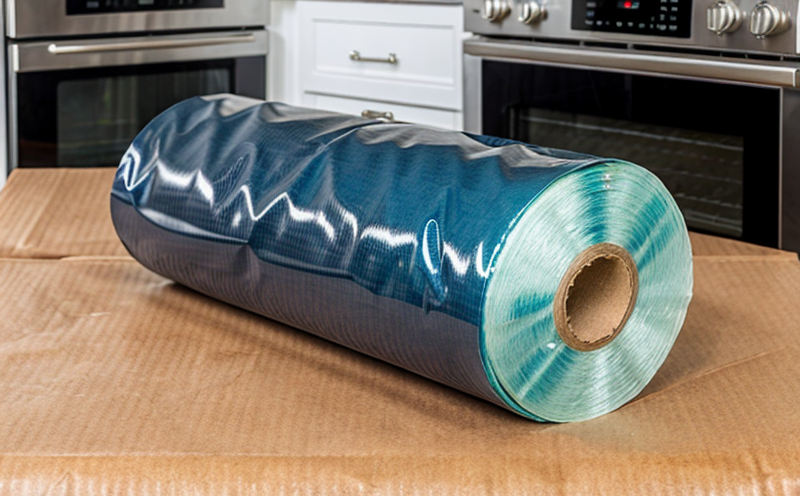BS EN ISO 20392 Water Vapor Permeability Testing of Plastic Wraps
The BS EN ISO 20392 standard provides a robust framework for determining the water vapor permeability (WVP) of plastic wraps and covers. This test is critical in ensuring that packaging materials meet specific performance requirements, particularly for food products, medical devices, and other goods sensitive to moisture exposure.
Water vapor permeability testing is essential because it helps manufacturers assess how well their plastic wraps can prevent the ingress or egress of water vapor. The ability to control this parameter directly impacts product shelf life, integrity, and safety. For instance, in the food industry, excessive water vapor transmission could lead to spoilage due to increased moisture content within packaged products.
The testing method involves placing a specimen between two chambers with controlled humidity levels. Over time, the amount of water vapor that passes through the material is measured under standardized conditions. The result provides insight into the barrier properties of the plastic wrap, which can then be used to optimize packaging design and enhance product quality.
This standard applies primarily to polyethylene (PE), polyvinyl chloride (PVC), ethylene vinyl alcohol copolymer (EVOH), and other flexible films commonly used in household applications. By adhering to BS EN ISO 20392, manufacturers can ensure compliance with international regulations while also improving their products' performance.
The testing process typically involves several steps:
- Specimen preparation: Ensuring the sample is cut to standard dimensions and thicknesses.
- Humidity control: Maintaining precise humidity levels in both chambers during the test.
- Measurement: Monitoring water vapor transmission over a set period using sophisticated equipment.
The results are reported as the water vapor permeability coefficient (in g/m²·day), which indicates how much water vapor can pass through a square meter of material per day. This value is crucial for comparing different materials or versions of the same material and making informed decisions about packaging design.
Compliance with this standard also extends beyond mere performance; it demonstrates a commitment to quality control and consumer safety. Many industries, such as food processing, pharmaceuticals, and electronics manufacturing, rely on these standards to ensure their products meet stringent quality benchmarks.
In conclusion, water vapor permeability testing is an indispensable tool for ensuring the integrity of plastic wraps used in household applications. By following BS EN ISO 20392, manufacturers can produce reliable, high-quality packaging that meets both regulatory and customer expectations.
Industry Applications
| Industry | Specific Application |
|---|---|
| Food Packaging | Ensuring freshness and preventing contamination. |
| Pharmaceutical Packaging | Maintaining product integrity and stability. |
| Medical Device Packaging | Protecting against moisture damage during storage and use. |
| Consumer Goods | Enhancing shelf life for various household items. |
| Electronics Manufacturing | Preventing corrosion in sensitive components. |
- Food Processing: Ensures product freshness and prevents contamination.
- Pharmaceuticals: Maintains drug stability and integrity during distribution.
- Medical Devices: Protects against moisture damage, ensuring safe use.
- Consumer Goods: Enhances shelf life for various household items.
- Electronics Manufacturing: Prevents corrosion in sensitive components.
Quality and Reliability Assurance
The BS EN ISO 20392 standard plays a pivotal role in quality assurance processes by providing consistent, reproducible methods for measuring water vapor permeability. This ensures that manufacturers can reliably assess their materials' performance across different production batches and environments.
Regular testing according to this standard helps identify potential issues early in the development process, allowing companies to make necessary adjustments before products reach market. Additionally, it supports continuous improvement efforts by providing data-driven insights into material behavior under various conditions.
In terms of reliability assurance, compliance with BS EN ISO 20392 ensures that packaged goods meet expected performance standards consistently. This builds trust with consumers and regulatory bodies alike, fostering long-term relationships and ensuring consistent quality across all product lines.
Moreover, adhering to this standard can help reduce waste and minimize environmental impact by optimizing material usage based on actual needs rather than over-engineered specifications.
International Acceptance and Recognition
The BS EN ISO 20392 standard is widely recognized globally for its accuracy and reliability in measuring water vapor permeability. Its acceptance across various countries underscores the importance placed on consistent quality standards within the industry.
Many major markets, including Europe, North America, Asia-Pacific, and others, have adopted this standard as a benchmark for assessing plastic wrap performance. This broad acceptance facilitates seamless trade between different regions, ensuring that products meet local requirements without additional testing.
The widespread use of BS EN ISO 20392 also promotes best practices in material selection and packaging design, contributing to overall industry advancement. By following this standard, manufacturers can ensure their products are competitive on a global scale while maintaining high standards of quality and reliability.





